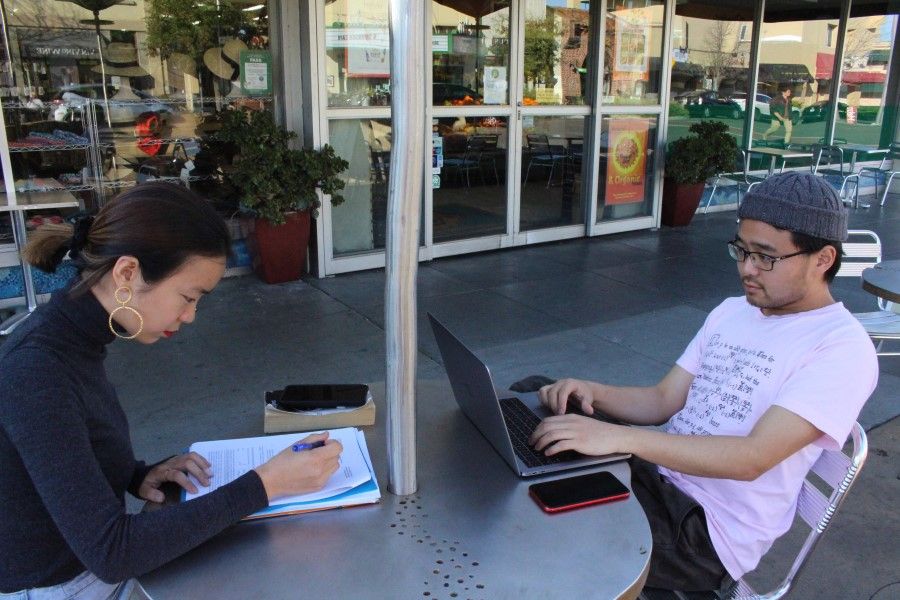Study in the US? Chinese students are having second thoughts

Li Qiqi, 22, was accepted in March to the University of Illinois at Urbana-Champaign, to read big data management. The young man from Beijing was looking forward to starting school this autumn, but with the coronavirus outbreak showing no signs of letting up and the likelihood that there would be a resurgence of the outbreak in autumn and winter, under the persuasion of his parents, he decided to delay going to the US.
Li told Zaobao that if the coronavirus comes back, he would rather stay in China and get a job, rather than spend 300,000 to 400,000 RMB (about S$60,000 to S$80,000) to go to the US, only to end up taking classes online.
...a survey of over 200 clients showed that about 10% of students have wavered in wanting to study in the US.
Young Chinese used to flock to the US to study, but due to the high number of coronavirus cases and news about discrimination and even violence against Chinese in recent months, some Chinese students who intended to go to the US to study or who are already there have postponed or cancelled their plans.
Wang Dong is the founder of EduLinkUs, a company in Beijing that helps with bespoke overseas study preparations. He said a survey of over 200 clients showed that about 10% of students have wavered in wanting to study in the US. Out of 114 Chinese students studying in the US, 12 have transferred back to China because of the coronavirus, while 18 out of 150 students have changed their minds about studying in the US.

Plans cancelled due to unfriendly environment
Companies like EduLinkUs are considered high-end services in China. Each client pays an average of 400,000 to 500,000 RMB for services to help them with procedures to go to the US. For students, this includes university fees and costs of lodging. And for these people with money to spare, the cost is not the primary consideration - it is other factors such as safety that have them cancelling plans to study in the US.
Secondary school student Zhu Hao, 15, was preparing to study at a boarding school in Boston. But since the US became the epicentre of the global pandemic, the federal government, as well as local governments, have started to seek accountability and compensation from China, while US senators have been publicly hostile to Chinese students. Zhu's mother was hesitant and decided to send her son to Canada, where "coronavirus measures are more reassuring."
While he (Li Qiqi) does not believe US society resembles what the Senator has portrayed, but "if it is really like that, then the country is really narrow-minded, and it doesn't matter whether or not I go."
She told Zaobao that as many countries are being xenophobic and discriminatory against Chinese, she actually does not want to send her son overseas, "but he has always attended international schools and would not be able to take the national exam (gaokao), and so he can only go overseas to continue his studies."
The good news is that public high schools in Canada cost about CA$15,000 a year (about S$15,000), which is half the cost of an international school in Beijing, which is a bit of relief for Zhu's mother. She stressed, "No senator in Canada is going to say that Chinese students can only study Shakespeare and not the sciences, are they?"
Recently, Tom Cotton, the Republican senator for Arkansas, sparked uproar in China when he proposed disallowing Chinese students from studying subjects related to science and technology, and only allowing them to read Shakespeare and the Federalist Papers. Coupled with the US move in mid-2018 to tighten visas for Chinese students reading sensitive subjects, Cotton's comments have diminished any good feeling among the Chinese people towards the US.
As to Cotton's comments, Li said his impression of the US was "freedom, inclusiveness, democracy". While he does not believe US society resembles what the Senator has portrayed, but "if it is really like that, then the country is really narrow-minded, and it doesn't matter whether or not I go."

Growth in Chinese students hits ten-year low last year as US becomes less attractive
In fact, since the China-US trade war, the Chinese clearly have a significantly poorer opinion of the US. The annual global survey report released in early April by US political analysis and consultancy organisation Eurasia Group Foundation (EGF) showed that 28% of Chinese respondents felt negatively about the US, up from 17% the year before, while those who felt positively dropped to 39%, from 58% previously.
...in the 2018-2019 academic year, while there were 370,000 Chinese students in the US, making up a third of the international students in the US, the rate of growth was the lowest in 10 years.
Due to reasons such as personal safety, not feeling welcome, and costly school fees, there has been a clear slowdown in growth in the number of Chinese students going to study in the US. According to the 2019 Open Doors Report released by the Institute of International Education (IIE), in the 2018-2019 academic year, while there were 370,000 Chinese students in the US, making up a third of the international students in the US, the rate of growth was the lowest in 10 years.
In March, the IIE released another report saying that international students contributed nearly US$41 billion (S$57.9 billion) to the US economy in 2019, and international education was the fifth largest service industry in the US, with every seven overseas students creating three job opportunities for the US. However, the report warned that anti-immigration sentiment and concern from international students and academics about their safety have led student numbers to fall for three consecutive years. From 2018 to 2019 (before the pandemic), international admissions to US tertiary institutions has dropped by 0.9%.
The report raised the concern that the US is losing its edge in the competition for talents.
Scandinavian countries as well as Australia are attracting international students with open immigration policies or lower education costs.
More open immigration, lower costs of education in Scandinavia and Australia
A US immigration consultant who declined to be named told Zaobao that after the outbreak spread globally, many clients were disappointed by the US's response and wavered over whether to let their children study or migrate there. One client had their application approved but was preparing to give it up, because they felt the US was only acting in the interests of the economy while ignoring the people's lives. This consultant said frankly that given this outbreak, she herself does not think leaving China is definitely better.
While Chinese families are hesitating over whether to go to the US, Scandinavian countries, as well as Australia, are attracting international students with open immigration policies or lower education costs.

"Cathy", a consultant with an agency in the US that makes arrangements for Chinese students, revealed that in the past two years, her organisation has been aggressively opening up cooperation with tertiary institutions in Scandinavia, in preparation for fewer Chinese students going to study in the US. She expects Chinese parents to be more careful about their children studying in the US. Scandinavia is comparatively safer and more stable, with its universities among the top in the world, which would be acceptable to Chinese families.
To many young Chinese people, the US is not as attractive as it was 20 or 30 years ago. Most students would choose not to stay after they complete their education.
Zhao Zixuan, 25, is a Masters student at the University of Pennsylvania. Before the outbreak, she was hired by a financial consulting firm in New York, but she told Zaobao: "When I first came to the US six years ago, I really wanted to get a green card. But now, I think going back to China would be good too."
The choice before her is not complicated: with qualifications from a well-known US university and experience working in the US, it would not be too difficult for her to find a job with an annual salary of 400,000 RMB. "That would not be too far from what a US company would pay," she said.
